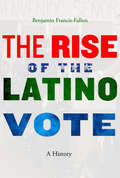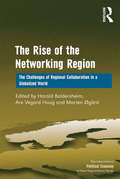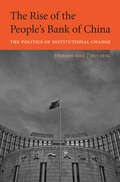- Table View
- List View
The Rise of the Labour Party 1880-1945
by Paul AdelmanThis popular study covers two major topics: the formation of the Labour Party and its emergence as the main rival to the conservatives. This transformation of the British political scene has been accounted for in a variety of ways. Dr Adelman examines these explanations and concludes that while there is a consensus about the reasons for the creation of the Labour Party there is no agreement about why it rose to such prominence.
The Rise of the Latino Vote: A History
by Benjamin Francis-FallonFrancis-Fallon returns to the origins of the U.S. “Spanish-speaking vote” to understand the history and potential of this political bloc. He finds that individual voters affiliate more with their particular ethnic communities than with the pan-ethnic Latino identity created for them, complicating the notion of a broader Latino constituency.
The Rise of the Masses: Spontaneous Mobilization and Contentious Politics
by Benjamin AbramsAn insightful examination of how intersecting individual motivations and social structures mobilize spontaneous mass protests. Between 15 and 26 million Americans participated in protests surrounding the murders of George Floyd, Ahmaud Arbery, Breonna Taylor, and others as part of the Black Lives Matter protests in 2020, which is only one of the most recent examples of an immense mobilization of citizens around a cause. In The Rise of the Masses, sociologist Benjamin Abrams addresses why and how people spontaneously protest, riot, and revolt en masse. While most uprisings of such a scale require tremendous resources and organizing, this book focuses on cases where people with no connection to organized movements take to the streets, largely of their own accord. Looking to the Arab Spring, Occupy Wall Street, and the Black Lives Uprising, as well as the historical case of the French Revolution, Abrams lays out a theory of how and why massive mobilizations arise without the large-scale planning that usually goes into staging protests. Analyzing a breadth of historical and regional cases that provide insight into mass collective behavior, Abrams draws on first-person interviews and archival sources to argue that people organically mobilize when a movement speaks to their pre-existing dispositions and when structural and social conditions make it easier to get involved—what Abrams terms affinity-convergence theory. Shedding a light on the drivers behind large spontaneous protests, The Rise of the Masses offers a significant theory that could help predict movements to come.
The Rise of the Masses: Spontaneous Mobilization and Contentious Politics
by Benjamin AbramsAn insightful examination of how intersecting individual motivations and social structures mobilize spontaneous mass protests. Between 15 and 26 million Americans participated in protests surrounding the murders of George Floyd, Ahmaud Arbery, Breonna Taylor, and others as part of the Black Lives Matter protests in 2020, which is only one of the most recent examples of an immense mobilization of citizens around a cause. In The Rise of the Masses, sociologist Benjamin Abrams addresses why and how people spontaneously protest, riot, and revolt en masse. While most uprisings of such a scale require tremendous resources and organizing, this book focuses on cases where people with no connection to organized movements take to the streets, largely of their own accord. Looking to the Arab Spring, Occupy Wall Street, and the Black Lives Uprising, as well as the historical case of the French Revolution, Abrams lays out a theory of how and why massive mobilizations arise without the large-scale planning that usually goes into staging protests. Analyzing a breadth of historical and regional cases that provide insight into mass collective behavior, Abrams draws on first-person interviews and archival sources to argue that people organically mobilize when a movement speaks to their pre-existing dispositions and when structural and social conditions make it easier to get involved—what Abrams terms affinity-convergence theory. Shedding a light on the drivers behind large spontaneous protests, The Rise of the Masses offers a significant theory that could help predict movements to come.
The Rise of the Middle Class in Contemporary China (The Great Transformation of China)
by Hainan Su Hong Wang Fenglin ChangThis book portrays the middle class in contemporary China with plain language and precise professional knowledge in an all-round, broad and responsible way from the perspectives of income, property, profession, education, consumption, investment, physiological and behavioral characteristics, history and development. It gives, in a logical order, the reasons for stimulating the rise of the middle class in contemporary China. It emphatically describes what the middle class is and what the middle class in contemporary China looks like. It also analyzes whether the middle class can rise in China and sheds light on the basic thinking, medium and long-term goals, main measures and current work priorities for achieving full rise of the middle class in contemporary China. As China becomes the world's largest economy, the new middle class will be the Chinese people facing the world; as such, this book will be of interest to sociologists, sinologists, political scientists, and economists.
The Rise of the Military Entrepreneur: War, Diplomacy, and Knowledge in Habsburg Europe
by Suzanne SutherlandThe Rise of the Military Entrepreneur explores how a new kind of international military figure emerged from, and exploited, the seventeenth century's momentous political, military, commercial, and scientific changes. In the era of the Thirty Years' War, these figures traveled rapidly and frequently across Europe using private wealth, credit, and connections to raise and command the armies that rulers desperately needed. Their careers reveal the roles international networks, private resources, and expertise played in building and at times undermining the state.Suzanne Sutherland uncovers the influence of military entrepreneurs by examining their activities as not only commanders but also diplomats, natural philosophers, information brokers, clients, and subjects on the battlefield, as well as through strategic marital and family allegiances. Sutherland focuses on Raimondo Montecuccoli (1609–80), a middling nobleman from the Duchy of Modena, who became one of the most powerful men in the Austrian Habsburg monarchy and helped found a new discipline, military science. The Rise of the Military Entrepreneur explains how Montecuccoli successfully met battlefield, court, and family responsibilities while contributing to the world of scholarship on an often violent, fragmented political-military landscape. As a result, Sutherland shifts the perspective on war away from the ruler and his court to instead examine the figures supplying force, along with their methods, networks, and reflections on those experiences.
The Rise of the Military Welfare State
by Jennifer MittelstadtAfter Vietnam the army promised its all-volunteer force a safety net long reserved for career soldiers: medical and dental care, education, child care, financial counseling, housing assistance, legal services. Jennifer Mittelstadt shows how this unprecedented military welfare system expanded at a time when civilian programs were being dismantled.
The Rise of the Networking Region: The Challenges of Regional Collaboration in a Globalized World (New Regionalisms Series)
by Are Vegard HaugHow regions and cities adapt to a Network Society and a globalized environment, the policies they pursue and how structures of governance are transformed in the pursuit of those policies are major themes in this volume. These issues are addressed with specific reference to the Nordic regions of Europe. Covering the four Nordic countries of Denmark, Finland, Norway, and Sweden plus the Faroe Islands, this volume charts the changes in networking activities and related development initiatives that have taken place over the last ten years. This means analysing regions in their pursuit of new policies, partnerships and styles of representation. Through this process regions are becoming partners and players in European integration and a movement of integrative regionalism is taking shape which is different from inward looking identity regionalism or self-centred competitive regionalism and takes regions beyond lobbying in Brussels.
The Rise of the Networking Region: The Challenges of Regional Collaboration in a Globalized World (New Regionalisms Series)
by Are Vegard HaugHow regions and cities adapt to a Network Society and a globalized environment, the policies they pursue and how structures of governance are transformed in the pursuit of those policies are major themes in this volume. These issues are addressed with specific reference to the Nordic regions of Europe. Covering the four Nordic countries of Denmark, Finland, Norway, and Sweden plus the Faroe Islands, this volume charts the changes in networking activities and related development initiatives that have taken place over the last ten years. This means analysing regions in their pursuit of new policies, partnerships and styles of representation. Through this process regions are becoming partners and players in European integration and a movement of integrative regionalism is taking shape which is different from inward looking identity regionalism or self-centred competitive regionalism and takes regions beyond lobbying in Brussels.
The Rise of the New Network Industries: Regulating Digital Platforms
by Juan Montero Matthias FingerCutting through the confusion around the nature and implications of digitalization, this book explores the rise of the new digital networks, how they affect traditional infrastructure, and how they will eventually need to be regulated. The authors examine how digitalization affects infrastructures in telecommunications, transport, and energy, and how digital platforms establish themselves as a new network on top of and in addition to traditional ones. Complex concepts are introduced through short and colorful stories about the founders of the most popular platforms (Google, Facebook, Skype, Uber, etc.) and how they grew to positions of power, drawing parallels with century-old traditional network industries’ monopoly power (AT&T, General Electric, etc.). The authors argue that these digital platforms strongly interfere with traditional infrastructures that are heavily regulated and provide essential services for society – meaning that digital platforms should be considered as a new and much more powerful type of infrastructure and will require regulation accordingly. A global audience of policy makers, public authorities, consultants, lawyers, students, and academics, as well as anyone with an interest in these digital platforms, will find this book enlightening and essential reading.
The Rise of the New Network Industries: Regulating Digital Platforms
by Juan Montero Matthias FingerCutting through the confusion around the nature and implications of digitalization, this book explores the rise of the new digital networks, how they affect traditional infrastructure, and how they will eventually need to be regulated. The authors examine how digitalization affects infrastructures in telecommunications, transport, and energy, and how digital platforms establish themselves as a new network on top of and in addition to traditional ones. Complex concepts are introduced through short and colorful stories about the founders of the most popular platforms (Google, Facebook, Skype, Uber, etc.) and how they grew to positions of power, drawing parallels with century-old traditional network industries’ monopoly power (AT&T, General Electric, etc.). The authors argue that these digital platforms strongly interfere with traditional infrastructures that are heavily regulated and provide essential services for society – meaning that digital platforms should be considered as a new and much more powerful type of infrastructure and will require regulation accordingly. A global audience of policy makers, public authorities, consultants, lawyers, students, and academics, as well as anyone with an interest in these digital platforms, will find this book enlightening and essential reading.
The Rise of the Norwegian Parliament: Studies in Norwegian Parliamentary Government
by Hilmar RommetvedtThis work presents eight studies of different but interrelated aspects of parliamentary government in post-war Norway. Split into three sections, it focuses on the formation of government, organization of parliament and the changing relations between parliament, executives, and organized interests.
The Rise of the Norwegian Parliament: Studies in Norwegian Parliamentary Government
by Hilmar RommetvedtThis work presents eight studies of different but interrelated aspects of parliamentary government in post-war Norway. Split into three sections, it focuses on the formation of government, organization of parliament and the changing relations between parliament, executives, and organized interests.
The Rise of the Outsiders: How Mainstream Politics Lost its Way
by Steve RichardsDiscover why outsiders from Trump to Corbyn are succeeding like never before - and what this means for you.In recent years, voters have deserted the political centre like never before. Whether it's Trump, Brexit, Le Pen, or Corbyn, outsiders and populists are flourishing on the far left and far right. Celebrated political commentator Steve Richards explores factors from globalization and fake news to rising immigration and stagnant wages. Richards argues that the reasons for the success of the outsider also sows the seeds of their eventual demise. If they do gain power, they inevitably become insiders themselves - and fail to live up to their extravagant promises.This landmark book examines the rapidly shifting global political landscape of the last decade, and is essential reading for anyone who has been bothered by Brexit, troubled by Trump or confused by Corbyn.
The Rise of the People's Bank of China: The Politics Of Institutional Change
by Stephen BellThe People’s Bank of China surpasses the Federal Reserve as the world’s biggest central bank. In the first comprehensive account of the evolution of central banking and monetary policy in reform China, Stephen Bell and Hui Feng show how the PBC’s authority grew from a Leninist party-state that once jealously guarded its control.
The Rise of the People's Bank of China: The Politics Of Institutional Change
by Stephen BellThe People’s Bank of China surpasses the Federal Reserve as the world’s biggest central bank. In the first comprehensive account of the evolution of central banking and monetary policy in reform China, Stephen Bell and Hui Feng show how the PBC’s authority grew from a Leninist party-state that once jealously guarded its control.
The Rise Of The Phoenix: The United States In A Restructured World Economy
by Jack N BehrmanThis book provides a grand design on a world scale that encompasses not only American interests but those of the other industrial countries, the developing world, and non-market economies. It suggests sectorial U.S. trade agreements based on the principles of efficiency, equity, and participation.
The Rise Of The Phoenix: The United States In A Restructured World Economy
by Jack N BehrmanThis book provides a grand design on a world scale that encompasses not only American interests but those of the other industrial countries, the developing world, and non-market economies. It suggests sectorial U.S. trade agreements based on the principles of efficiency, equity, and participation.
The Rise of the Public Authority: Statebuilding and Economic Development in Twentieth-Century America
by Gail RadfordIn the late nineteenth century, public officials throughout the United States began to experiment with new methods of managing their local economies and meeting the infrastructure needs of a newly urban, industrial nation. Stymied by legal and financial barriers, they created a new class of quasi-public agencies called public authorities. Today these entities operate at all levels of government, and range from tiny operations like the Springfield Parking Authority in Massachusetts, which runs thirteen parking lots and garages, to mammoth enterprises like the Tennessee Valley Authority, with nearly twelve billion dollars in revenues each year. In The Rise of the Public Authority, Gail Radford recounts the history of these inscrutable agencies, examining how and why they were established, the varied forms they have taken, and how these pervasive but elusive mechanisms have molded our economy and politics over the past hundred years.
The Rise of the Public Authority: Statebuilding and Economic Development in Twentieth-Century America
by Gail RadfordIn the late nineteenth century, public officials throughout the United States began to experiment with new methods of managing their local economies and meeting the infrastructure needs of a newly urban, industrial nation. Stymied by legal and financial barriers, they created a new class of quasi-public agencies called public authorities. Today these entities operate at all levels of government, and range from tiny operations like the Springfield Parking Authority in Massachusetts, which runs thirteen parking lots and garages, to mammoth enterprises like the Tennessee Valley Authority, with nearly twelve billion dollars in revenues each year. In The Rise of the Public Authority, Gail Radford recounts the history of these inscrutable agencies, examining how and why they were established, the varied forms they have taken, and how these pervasive but elusive mechanisms have molded our economy and politics over the past hundred years.
The Rise of the Public Authority: Statebuilding and Economic Development in Twentieth-Century America
by Gail RadfordIn the late nineteenth century, public officials throughout the United States began to experiment with new methods of managing their local economies and meeting the infrastructure needs of a newly urban, industrial nation. Stymied by legal and financial barriers, they created a new class of quasi-public agencies called public authorities. Today these entities operate at all levels of government, and range from tiny operations like the Springfield Parking Authority in Massachusetts, which runs thirteen parking lots and garages, to mammoth enterprises like the Tennessee Valley Authority, with nearly twelve billion dollars in revenues each year. In The Rise of the Public Authority, Gail Radford recounts the history of these inscrutable agencies, examining how and why they were established, the varied forms they have taken, and how these pervasive but elusive mechanisms have molded our economy and politics over the past hundred years.
The Rise of the Public Authority: Statebuilding and Economic Development in Twentieth-Century America
by Gail RadfordIn the late nineteenth century, public officials throughout the United States began to experiment with new methods of managing their local economies and meeting the infrastructure needs of a newly urban, industrial nation. Stymied by legal and financial barriers, they created a new class of quasi-public agencies called public authorities. Today these entities operate at all levels of government, and range from tiny operations like the Springfield Parking Authority in Massachusetts, which runs thirteen parking lots and garages, to mammoth enterprises like the Tennessee Valley Authority, with nearly twelve billion dollars in revenues each year. In The Rise of the Public Authority, Gail Radford recounts the history of these inscrutable agencies, examining how and why they were established, the varied forms they have taken, and how these pervasive but elusive mechanisms have molded our economy and politics over the past hundred years.
The Rise of the Public Authority: Statebuilding and Economic Development in Twentieth-Century America
by Gail RadfordIn the late nineteenth century, public officials throughout the United States began to experiment with new methods of managing their local economies and meeting the infrastructure needs of a newly urban, industrial nation. Stymied by legal and financial barriers, they created a new class of quasi-public agencies called public authorities. Today these entities operate at all levels of government, and range from tiny operations like the Springfield Parking Authority in Massachusetts, which runs thirteen parking lots and garages, to mammoth enterprises like the Tennessee Valley Authority, with nearly twelve billion dollars in revenues each year. In The Rise of the Public Authority, Gail Radford recounts the history of these inscrutable agencies, examining how and why they were established, the varied forms they have taken, and how these pervasive but elusive mechanisms have molded our economy and politics over the past hundred years.
The Rise of the Public Authority: Statebuilding and Economic Development in Twentieth-Century America
by Gail RadfordIn the late nineteenth century, public officials throughout the United States began to experiment with new methods of managing their local economies and meeting the infrastructure needs of a newly urban, industrial nation. Stymied by legal and financial barriers, they created a new class of quasi-public agencies called public authorities. Today these entities operate at all levels of government, and range from tiny operations like the Springfield Parking Authority in Massachusetts, which runs thirteen parking lots and garages, to mammoth enterprises like the Tennessee Valley Authority, with nearly twelve billion dollars in revenues each year. In The Rise of the Public Authority, Gail Radford recounts the history of these inscrutable agencies, examining how and why they were established, the varied forms they have taken, and how these pervasive but elusive mechanisms have molded our economy and politics over the past hundred years.
The Rise of the Radical Right in the Global South (Routledge Studies in Fascism and the Far Right)
by Rosana Pinheiro-Machado Tatiana Vargas-MaiaThe Rise of the Radical Right in the Global South is the first academic study—adopting an interdisciplinary and international perspective—to offer a comprehensive and groundbreaking framework for understanding the emergence and consolidation of different radical-right movements in Global South countries in the twenty-first century. From deforestation and the anti-vaccine movement in Bolsonaro’s Brazil to the massacre of religious minorities in Modi’s India, the rise of the radical right in the Global South is in the news every day. Not long ago, some of these countries were globally celebrated as emerging economies that consolidated vibrant democracies. Nonetheless, they never overcame structural problems including economic inequality, social violence, cultural conservatism, and political authoritarianism. Featuring case studies from Brazil, India, the Philippines, and South Africa, and more generally from Africa and Latin America, this book analyses future scenarios and current alternatives to this political movement to the radical right. It proposes a shift of focus in examining such a trend, adopting a view from the Global South; conventional theoretical tools developed around the experience in Global North countries are not enough. The authors show that the radical right in the Global South should be analysed through specific lenses, considering national historical patterns of political and economic development and instability. They also warn that researching these countries may differ from contexts where democratic institutions are more reliable. This does not mean abandoning a transnational understanding of the radical right; rather, it calls for the opposite: the chapters examine how the radical right is invented, adapted, modified, and resisted in specific regions of the globe. This volume will be of interest to all those researching the radical right and the politics of development and the Global South.














